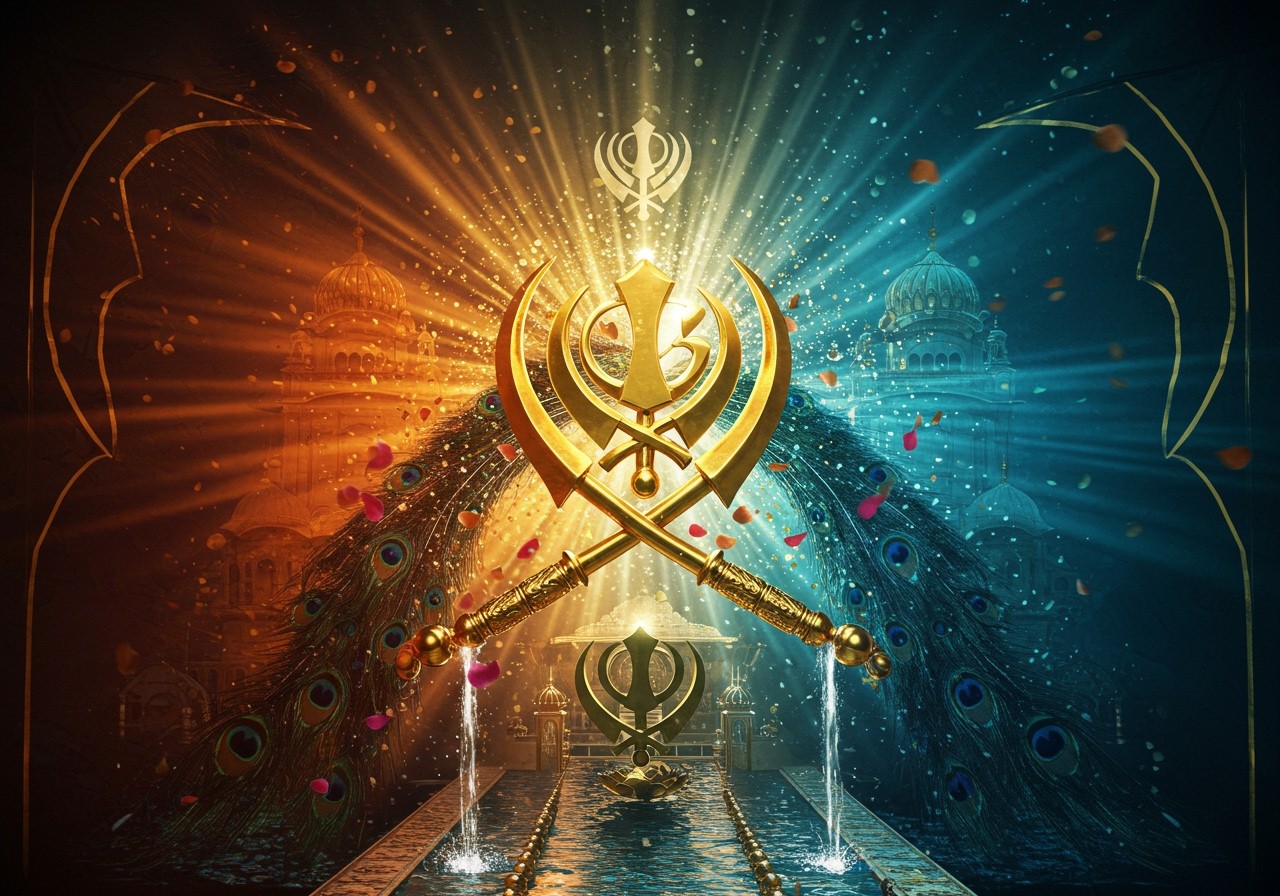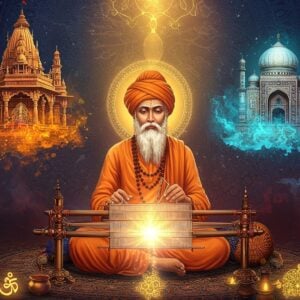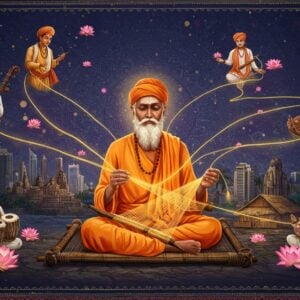
Sikhism, a faith deeply rooted in symbolism and profound teachings, holds two emblems, Ek Onkar and the Khanda, in high regard. These symbols are not mere artistic expressions; they embody the core principles of Sikh beliefs, guiding the daily lives of Sikhs worldwide. Let’s delve into the significance of these powerful emblems.
Understanding Ek Onkar: The Symbol of One God
Ek Onkar, a cornerstone of Sikhism, represents the belief in the oneness of God. This sacred phrase, signifying “One God,” opens the Guru Granth Sahib, the holy scripture of Sikhs, emphasizing its paramount importance. Ek Onkar underscores the principle of monotheism and fosters unity amidst diversity. It stresses the equality of all beings, transcending caste and class distinctions, and forms the heart of Sikh prayers and worship. Ek Onkar’s visual representation is widespread in Sikh art and literature, symbolizing spiritual devotion and the interconnectedness of all creation. You can explore more about core beliefs and practices on this page.
The Symbolism of the Khanda: A Deeper Look
The Khanda, another potent symbol in Sikhism, is deeply intertwined with Sikh identity and values. While seemingly simple, each element of the Khanda holds profound meaning.
-
The Double-Edged Sword: At its core lies a double-edged sword, representing divine knowledge and the power to distinguish truth from falsehood. This sword serves as a reminder of the importance of wisdom and the continual pursuit of knowledge, urging Sikhs to cut through the veil of ignorance.
-
The Chakram: Encircling the sword is the chakram, a circular weapon symbolizing the eternal and unchanging nature of God, known as Waheguru. Just as the circle has no beginning or end, Waheguru is timeless and infinite. It represents the continuous cycle of life and the unity of all creation.
-
The Two Kirpans: Two single-edged swords, known as kirpans, flank the chakram. These represent the delicate balance between spiritual and temporal duties. One sword signifies spiritual growth and inner development, while the other represents worldly responsibilities and engagement with society. Together, they call upon Sikhs to maintain equilibrium in life, harmonizing devotion with action.
Beyond personal spirituality, the Khanda historically represents resilience and sovereignty for the Sikh community. In times of tribulation, it has served as a beacon of strength and courage, reminding Sikhs of the empowering teachings of their faith. You can find the Khanda proudly displayed on Sikh flags (Nishan Sahib), emblems, and during religious ceremonies. Its presence strengthens community bonds and acts as a powerful symbol of collective identity.
Interpreting Khanda and Ek Onkar Together: A Holistic View
Ek Onkar and the Khanda, when considered together, offer a comprehensive understanding of Sikhism’s core principles. Ek Onkar establishes the foundation of faith with its message of oneness and equality, while the Khanda builds upon this foundation by emphasizing balance, wisdom, and righteous action. These symbols inspire Sikhs to live their faith in every facet of life, nurturing inner spirituality while advocating for social justice. Stories from Sikh history illustrate how these symbols have guided communities through periods of peace and adversity alike. By integrating these symbols into their daily lives, Sikhs honor their rich heritage, demonstrating that spiritual pursuits and worldly responsibilities can coexist harmoniously. Delve deeper into the Ramayana’s enduring influence on Indian culture here.
Cultural and Artistic Representations: Expressions of Faith
Sikh culture vibrantly expresses these symbols through various art forms. Artists capture the essence of Ek Onkar and the Khanda in paintings, sculptures, and digital media, inspiring creativity while preserving tradition. Gurdwaras, the sacred places of worship, often incorporate these symbols into their architecture, enriching the spiritual ambiance and cultural richness of these spaces. In the modern era, many Sikhs display Ek Onkar and Khanda wallpapers on their devices, seamlessly blending tradition with contemporary life.
The Role of Khanda and Ek Onkar in Sikh Rituals: Strengthening Spiritual Bonds
Ek Onkar and the Khanda hold special significance in Sikh rituals. During Amrit Sanchar, the Sikh initiation ceremony, these symbols reinforce the individual’s spiritual commitment. The recitation of Ek Onkar during daily prayers affirms the belief in one God. The Khanda is also present during the preparation of Karah Prasad, a sacred offering symbolizing community and sharing. Moreover, these symbols strengthen community ties during Nagar Kirtans, processions filled with devotion and song, serving as a reminder of shared values and aspirations.
Modern Relevance and Online Presence: Adapting to the Digital Age
In today’s digital world, Ek Onkar and the Khanda have found new avenues for expression. Online platforms showcase their significance and promote religious understanding. Social media plays a vital role in disseminating knowledge about these symbols globally. Many online platforms offer authentic ritual items featuring Ek Onkar and the Khanda, catering to tech-savvy individuals seeking a deeper connection with their heritage. This digital presence presents both challenges and opportunities, allowing for the preservation of traditional meanings while adapting to a rapidly evolving world.
Shop Authentic Sikh Religious Items at Poojn.in
Poojn.in provides a curated selection of authentic Sikh religious items to support your spiritual practices:
- Pure brass Khanda symbols for home and gurdwara display
- High-quality Ek Onkar wall hangings in various sizes
- Traditional Kara (steel bangles) in multiple sizes
- Prayer mats and aasan for comfortable meditation
- Gutka Sahib and religious texts in protective covers
- Incense sticks and holders for ceremonies
Visit our website www.poojn.in to explore the full collection. Decorative items are also available. You can also reach us at:
- Phone: 03369029784
- WhatsApp: 9476142738
We offer:
- Pan-India delivery
- Secure packaging
- Quality assurance
- Easy returns
- Cash on delivery available
- Bulk orders welcome
Embracing the Timeless Wisdom of Sikh Symbols: A Guiding Light
Ek Onkar and the Khanda are more than mere symbols; they are guiding lights for Sikhs across generations, encapsulating the essence of Sikhism. They teach us the importance of unity, balance, and resilience. Rich in meaning, these symbols continue to inspire and connect individuals to their heritage, regardless of their location. In the heart of every Sikh, these symbols ignite a passion for truth and justice, reminding us to live with purpose, embracing both our spiritual and worldly responsibilities. As they adorn homes, gurdwaras, and digital spaces, Ek Onkar and the Khanda remain steadfast in their message of hope and harmony. For those seeking a deeper connection with their roots, these symbols offer a pathway to understanding and belonging. Embrace the wisdom of Ek Onkar and the Khanda, and let them guide you in living a life of integrity and compassion. In doing so, we honor the rich tapestry of Sikh culture and its timeless teachings. If you’re interested in exploring content gaps and creating engaging blog topics, you might find this resource helpful. For insights into the spiritual core of India, this blog post on Varanasi could be enlightening.
FAQs on Ek Onkar & Khanda
What is Ek Onkar? Ek Onkar is a fundamental symbol and phrase in Sikhism, representing the one supreme reality, the ultimate truth, or God. It is the opening phrase of the Guru Granth Sahib, signifying its central importance in Sikh belief.
Why is Khanda important in Sikhism? The Khanda is a powerful symbol of strength, unity, and the core principles of Sikhism. It embodies the essence of Sikh values and reminds Sikhs of their commitment to truth, justice, and spiritual growth.
How does Ek Onkar relate to Sikh beliefs? Ek Onkar signifies the core Sikh belief in one God, a single divine force that pervades all creation. This concept promotes unity and equality among all people, regardless of background or social standing.
What does each component of the Khanda symbolize? The double-edged sword represents divine knowledge and the power to discern truth from falsehood; the circle symbolizes the eternal and unchanging nature of God (Waheguru); and the two crossed swords represent the balance between spiritual and temporal duties – Miri and Piri.
Are Ek Onkar and Khanda used in Sikh rituals? Yes, both symbols play significant roles in Sikh rituals and ceremonies. Ek Onkar is recited in prayers and hymns, while the Khanda is often displayed in gurdwaras and used in ceremonies like Amrit Sanchar (initiation).
Can Ek Onkar and Khanda be found in Sikh art and decoration? Absolutely. Ek Onkar and Khanda are prevalent in Sikh art, decorations, jewelry, and even digital wallpapers, serving as constant reminders of Sikh values and beliefs. They are integral to Sikh visual culture.
Is it appropriate to wear jewelry with Ek Onkar and Khanda symbols? Yes, wearing jewelry featuring Ek Onkar and Khanda is a common practice among Sikhs as a way to express their faith and identity. It’s a way to keep these sacred symbols close and reflect on their meanings throughout the day. You can find beautiful Khanda pendants here, here and here.
How can one learn more about Ek Onkar and Khanda? Learning more about Ek Onkar and Khanda can involve visiting a local gurdwara, engaging with the Sikh community, reading Sikh scriptures like the Guru Granth Sahib, exploring online resources, and seeking guidance from knowledgeable individuals within the Sikh faith.


